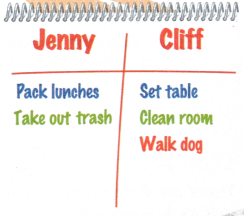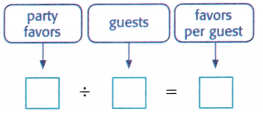All the solutions provided in McGraw Hill Math Grade 4 Answer Key PDF Chapter 3 Lesson 5 Multiplication Properties and Division Rules will give you a clear idea of the concepts.
McGraw-Hill My Math Grade 4 Answer Key Chapter 3 Lesson 5 Multiplication Properties and Division Rules
Math in My World
Example 1
The table shows Jenny’s and Cliff’s chores. Jenny earns $3 for each chore and Cliff earns $2 for each chore. How much does each person earn for completing chores?

Complete each number sentence.

So, each person earns ___. The order in which the factors are multiplied does not change the product.
Answer:
Given that,
Jenny has 2 chore.
Cliff has 3 chore.
Jenny earns $3 for each chore.
Cliff earns $2 for each chore.

So, each person earns $6.
It is commutative property of multiplication.
Example 2
There are 9 party favors and 9 guests. How many party favors will each guest get?
Complete the number sentence.

A nonzero number divided by the same number is 1.
So, each guest will get ____ party favor.
Answer:
Given that,
There are 9 party favors and 9 guests.

It is multiplicative identity.
So, each guest will get 1 party favor.
Talk Math
Explain why the Identity Property of Multiplication uses 1 while the Identity Property of Addition uses 0.

Answer:
The addition is the process of adding one number to another number. It is 2 + 0 = 2.
The multiplication is the process any number multiplied by 1 then you get same number.
It is 2 x 1 = 2.
Guided Practice
Identify the property or rule shown by each equation.
Question 1.
12 × 0 = 0
Answer:
Any number is multiplying by 0 then you get the product is 0 is the Zero property.
12 x 0 = 0.
So, It is the Zero property of multiplication.
Question 2.
8 × 5 = 5 × 8
Answer:
The order in which the factors are multiplied does not change the product is called commutative property of multiplication.
8 × 5 = 40.
5 × 8 = 40.
Therefore 8 × 5 = 5 × 8.
It is Commutative property of multiplication.
Independent Practice
Identify the property or rule shown by each equation.
Question 3.
6 ÷ 1 = 6
Answer:
6 divided by 1 equal to 6.
6 ÷ 1 = 6.
It is ones in division rule.
Any number divided by 1 equal to the itself is called ones in division.
Question 4.
10 ÷ 10 = 1
Answer:
10 divided 10 equal to 1.
10 ÷ 10 = 1.
A nonzero number divided by the same number is 1.
It is multiplicative identity.
Question 5.
8 × 0 = 0
Answer:
Multiplication of 8 with 0 then you get 0.
8 x 0 = 0.
Any number multiplying with 0 then you get 0.
It is a zero property of multiplication.
Question 6.
0 ÷ 12 = 0
Answer:
0 divided by 12 equal to 0.
0 ÷ 12 = 0.
It is Zero divided by any number rule.
The 0 dividing by any number gives 0.
Question 7.
22 × 1 = 22
Answer:
Multiplication of 22 with 1 then you get 22.
22 x 1 = 22.
Any number divided by 1 then the product is 1 is called the identity property of multiplication.
It is the identity property of multiplication.
Question 8.
4 × 3 = 3 × 4
Answer:
Multiplication of 4 with 3 then you get 12.
4 x 3 = 12,
Multiplication of 3 with 4 then you get 12.
3 x 4 = 12.
It is a commutative property of multiplication.
Algebra Find each unknown number. Identify the property or rule.
Question 9.
3 ÷ ![]() = 1
= 1
![]() = ____
= ____
Answer:
3 divided by 3 equal to 1.
3 ÷ 3 = 1.
It is multiplicative identity.
It is any number divided by itself then the product is 1.
Question 10.
![]() × 8 = 8 × 4
× 8 = 8 × 4
![]() = ___
= ___
Answer:
Multiplication of 4 with 8 then you get 32.
Multiplication f 8 with 4 then you get 32.
4 x 8 = 32.
8 x 4 = 32.
It is commutative property of multiplication.
Question 11.
![]() ÷ 11 = 0
÷ 11 = 0
![]() = ___
= ___
Answer:
0 divided by 11 equal to 0.
0 ÷ 11 = 0.
It is Zero divided by any number rule.
The 0 dividing by any number gives 0.
Question 12.
![]() × 1 = 15
× 1 = 15
![]() = ____
= ____
Answer:
Multiplication of 15 with 1 then you get 15.
15 x 1 = 15.
It is the identity property of multiplication.
Problem Solving
Question 13.
On a hiking trip, Tamika and Bryan hiked 7 miles a day. They hiked for 5 days. Kurt and Sade hiked 5 miles a day. How many days did it take Kurt and Sade to hike the same distance as Tamika and Bryan? Write a number sentence to solve.
Answer:
Given that,
Tamika and Bryan hiked 7 miles a day. They hiked for 5 days.
It is 7 x 5 = 35.
Tamika and Bryan hiked 35 miles in 5 days.
Kurt and Sade hiked 5 miles a day.
If the Kurt and Sade hike for 7 days.
It is 5 x 7 = 35.
Therefore Kurt and Sade hiked for 7 days to same distance has Tamika and Bryan.
Question 14.
There are 6 shelves in the library that each have 8 books displayed. How many books are on all of the shelves? Use the Commutative Property to write the multiplication sentence in two ways. Then solve.
Answer:
Given that,
There are 6 shelves in the library that each have 8 books displayed.
It is 6 x 8 = 48.
Therefore the number of books in all is 48.
The another way is 8 x 6 = 48.
Question 15.
Mathematical PRACTICE 7 Identify Structure Explain why it is helpful to understand the Identity Property of Multiplication.
Answer:
Identity Property of Multiplication is any number multiplied by 1 then the product is it self.
Identity Property of Multiplication is used in mathematics to solve the missing numbers of variables.
HOT Problems
Question 16.
Mathematical PRACTICE 1 Make a Plan Write a multiplication problem that uses the Commutative Property of Multiplication to solve.
Answer:
Ravi has 4 packs of flowers with 3 flowers in each pack. He has 3 leaves of birds with 4 leaves in each pack. Write two multiplication sentences to show how many flowers and leaves are there.
The number of flowers are 4 x 3 = 12.
The number of leaves are 3 x 4 = 12.
Therefore 4 x 3 = 3 x 4.
It is a commutative property of multiplication.
Question 17.
? Building on the Essential Question How do multiplication properties and division rules help you to multiply and divide?
Answer:
The division is the inverse of multiplication. so, the rules of both the division and multiplication are same. so, multiplication properties and division rules help you to multiply and divide.
McGraw Hill My Math Grade 4 Chapter 3 Lesson 5 My Homework Answer Key
Practice
Identify the property or rule shown by each equation.
Question 1.
9 ÷ 1 = 9
Answer:
9 divided by 1 equal to 9.
9 ÷ 1 = 9.
It is ones in division rule.
Any number divided by 1 equal to the itself is called ones in division.
Question 2.
33 × 1 = 33
Answer:
33 x 1 = 33.
Here the 33 is multiplying with 1 then you get the number 33.
It is the identity property of multiplication.
Problem Solving
Complete each number sentence. Identify the property or rule.
Question 3.
5 ÷ ___ = 5
Answer:
5 divided by 1 equal to 5.
5 ÷ 1 = 5.
It is ones in division rule.
Any number divided by 1 equal to the itself is called ones in division.
Question 4.
9 × 8 = 8 × ____
Answer:
Multiplication of 9 with 8 then you get 72.
Multiplication of 8 with 9 equal to 72.
9 x 8 = 72.
8 x 9 = 72.
Therefore 9 x 8 = 8 x 9.
It is commutative property of multiplication.
Question 5.
___ ÷ 12 = 0
Answer:
0 divided by 12 equal to 0.
0 ÷ 12 = 0.
It is Zero divided by any number.
The 0 dividing by any number gives 0.
Question 6.
Mathematical PRACTICE 7 Identify Structure Dennis has 3 packs of pens with 2 pens in each pack. He has 2 packs of pencils with 3 pencils in each pack. Write two multiplication sentences to show how many pens and pencils he has.
Answer:
Given that,
Dennis has 3 packs of pens with 2 pens in each pack.
It is 3 x 2 = 6.
He has 2 packs of pencils with 3 pencils in each pack.
It is 2 x 3 = 6.
Therefore the the pencils and pes are equal it is 6.
It is commutative property of multiplication.
Vocabulary Check
Write a number sentence for each rule or property.
Question 7.
Ones in Division ______
Answer:
It means any number divided by 1 equal to the itself is called ones in division.
Question 8.
Commutative Property of Multiplication ______
Answer:
The order in which the factors are multiplied does not change the product is called commutative property of multiplication.
Question 9.
Zeros in Division ________
Answer:
It is Zero divided by any number.
The 0 dividing by any number gives 0.
Question 10.
Zero Property of Multiplication
_______________
Answer:
Any number is multiplying by 0 then you get the product is 0 is called the Zero property.
Question 11.
Identity Property of Multiplication
_______________
Answer:
If any number multiplying with 1 it gives the same number itself is called identity property of multiplication.
Test Practice
Question 12.
The Zero Property of Multiplication tells you that 25 × 0 is equal to what number?
A. 0
B. 1
C. 7
D. 25
Answer:
The Zero Property of Multiplication tells you that 25 × 0 is equal to 0.
Option A is the correct answer.